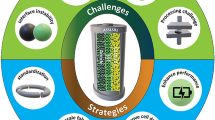Abstract
Electronic conductor-free FeF2 films deposited by pulsed laser deposition (PLD) were studied as potential cathode materials for Li-ion batteries. The correlation between microstructural evolution and electrochemical cycling of PLD FeF2 films was investigated. Cross-sectional transmission electron microscopy (X-TEM) of the films indicates that they are composed of particles varying in size between 10 and 50 nm. 20–50 nm particles were initially deposited on the sample substrate and were not cycled, irrespective of film thickness and applied C-rate; 10 nm particles were cycled at low C-rates. Cross-sectional TEM of delithiated films shows that the reconversion process starts from the bottom to the top of the film by forming FeF2 on the 20–50 nm FeF2 particles. Galvanostatic measurements show that thinner FeF2 films have higher capacities and expansion percentages than thick films, but the measured capacity of these films is still less than the theoretical capacity. These results suggest that the cycling performance of PLD FeF2 is limited by electron transport and that the addition of an electronic conductor will increase the cycling capacity of FeF2 films.










Similar content being viewed by others
References
Rougier A, Portemer F, Quédé A, El Marssi M (1999) Characterization of pulsed laser deposited WO3 thin films for electrochromic devices. Appl Surf Sci 153:1–9. doi:10.1016/S0169-4332(99)00335-9
Bouessay I, Rougier A, Poizot P, Moscovici J, Michalowicz A, Tarascon JM (2005) Electrochromic degradation in nickel oxide thin film: a self-discharge and dissolution phenomenon. Electrochim Acta 50:3737–3745. doi:10.1016/j.electacta.2005.01.020
Pralong V, Leriche JB, Beaudoin B, Naudin E, Morcrette M, Tarascon JM (2004) Electrochemical study of nanometer Co3O4 Co, CoSb3 and Sb thin films toward lithium. Solid State Ion. 166:295–305. doi:10.1016/j.ssi.2003.11.018
Matsuyama T, Sakuda A, Hayashi A, Togawa Y, Mori S, Tatsumisago M (2012) Preparation of amorphous TiS x thin film electrodes by the PLD method and their application to all-solid-state lithium secondary batteries. J Mater Sci 47:6601–6606. doi:10.1007/s10853-012-6594-9
Makimura Y, Rougier A, Tarascon J-M (2006) Pulsed laser deposited iron fluoride thin films for lithium-ion batteries. Appl Surf Sci 252:4587–4592. doi:10.1016/j.apsusc.2005.06.043
Badway F, Pereira N, Cosandey F, Amatucci GG (2003) Carbon-metal fluoride nanocomposites: structure and electrochemistry of FeF3: C. J Electrochem Soc 150:A1209–A1218. doi:10.1149/1.1596162
Makimura Y, Rougier A, Laffont L et al (2006) Electrochemical behaviour of low temperature grown iron fluoride thin films. Electrochem Commun 8:1769–1774. doi:10.1016/j.elecom.2006.08.004
Santos-Ortiz R, Volkov V, Schmid S et al (2013) Microstructure and electronic band structure of pulsed laser deposited iron fluoride thin film for battery electrodes. ACS Appl Mater Interfaces 5:2387–2391. doi:10.1021/am3017569
Ellis BL, Lee KT, Nazar LF (2010) Positive electrode materials for Li-ion and Li-batteries. Chem Mater 22:691–714. doi:10.1021/cm902696j
Sina M, Nam KW, Su D et al (2013) Structural phase transformation and Fe valence evolution in FeOxF2-x/C nanocomposite electrodes during lithiation and de-lithiation processes. J Mater Chem A 1:11629–11640. doi:10.1039/c3ta12109g
Goodenough JB, Kim Y (2009) Challenges for rechargeable Li batteries. Chem Mater 22:587–603. doi:10.1021/cm901452z
Xiang H, Zhang D, Jin Y, Chen C, Wu J, Wang H (2011) Hydrothermal synthesis of ultra-thin LiFePO4 platelets for Li-ion batteries. J Mater Sci 46:4906–4912. doi:10.1007/s10853-011-5403-1
Li J, Zhao R, He X, Liu H (2009) Preparation of LiCoO2 cathode materials from spent lithium–ion batteries. Ionics 15:111–113. doi:10.1007/s11581-008-0238-8
Wang F, Robert R, Chernova NA et al (2011) Conversion reaction mechanisms in lithium ion batteries: study of the binary metal fluoride electrodes. J Am Chem Soc 133:18828–18836. doi:10.1021/ja206268a
Reddy MA, Breitung B, Chakravadhanula VSK et al (2013) CFx derived carbon–FeF2 nanocomposites for reversible lithium storage. Adv Energy Mater 3:308–313. doi:10.1002/aenm.201200788
Rangan S, Thorpe R, Bartynski RA et al (2012) Conversion reaction of FeF2 thin films upon exposure to atomic lithium. J Phys Chem C 116:10498–10503. doi:10.1021/jp300669d
Bai Y, L-w Yang F Wu et al (2013) High performance FeFx/C composites as cathode materials for lithium-ion batteries. J Renew Sustain Energy 5(021402):021401–021409. doi:10.1063/1.4798423
Armstrong MJ, Panneerselvam A, O’Regan C, Morris MA, Holmes JD (2013) Supercritical-fluid synthesis of FeF2 and CoF2 Li-ion conversion materials. J Mater Chem A 1:10667–10676. doi:10.1039/c3ta12436c
Giannuzzia LA, Stevieb FA (1999) A review of focused ion beam milling techniques for TEM specimen preparation. Micron 30:197–204. doi:10.1016/S0968-4328(99)00005-0
Boyd S, Amatucci G, Pereira N, Greenbaum S (2013) Solid electrolyte interphase formation in iron (II) fluoride conversion electrodes. 224th ESC Meeting MA2013-02, pp 933–933
Yamakawa N, Jiang M, Key B, Grey CP (2009) Identifying the local structures formed during lithiation of the conversion material, iron fluoride, in a Li ion battery: a solid-state NMR, X-ray diffraction, and pair distribution function analysis study. J Am Chem Soc 131:10525–10536. doi:10.1021/ja902639w
Zhang SS, Xu K, Jow TR (2002) A thermal stabilizer for LiPF6-based electrolytes of Li-ion cells. Electrochem Solid State Lett 5:A206–A208. doi:10.1149/1.1499669
Yang L, Lucht BL (2009) Inhibition of electrolyte oxidation in lithium ion batteries with electrolyte additives. Electrochem Solid State Lett 12:A229–A231. doi:10.1149/1.3238486
Li L, Meng F, Jin S (2012) High-capacity lithium-ion battery conversion cathodes based on iron fluoride nanowires and insights into the conversion mechanism. Nano Lett 12:6030–6037. doi:10.1021/nl303630p
Qiu SR, Yarmoff JA (2001) Self-limiting growth of transition-metal fluoride films from the reaction with XeF2. Phys Rev B 63:1154091–1154097
Acknowledgements
The corresponding author acknowledges the Scientific Research Support Fund (SRSF), Jordan, for supporting this work performed at the University of Florida.
Author information
Authors and Affiliations
Corresponding author
Rights and permissions
About this article
Cite this article
Al Khateeb, S., Lind, A.G., Santos-Ortiz, R. et al. Cycling performance and morphological evolution of pulsed laser-deposited FeF2 thin film cathodes for Li-ion batteries. J Mater Sci 50, 5174–5182 (2015). https://doi.org/10.1007/s10853-015-9062-5
Received:
Accepted:
Published:
Issue Date:
DOI: https://doi.org/10.1007/s10853-015-9062-5




